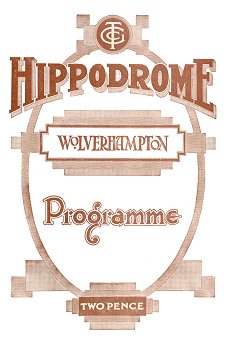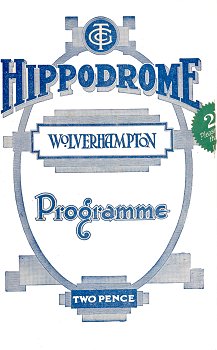|

The front cover of the programme from 23rd
April, 1934. |
It all began behind the ‘Boot and Star’
public house, which stood on the corner of North Street and
Queen Square, when the ‘Gaiety Music Hall’ was built there in
the 1860s. It was very successful and later became known as ‘The
Empire Music Hall’ with the public house changing its name to
the 'Empire Vaults'.
By the late 1890s it had fallen into a bad
state of repair and it was decided to demolish the music hall
along with the public house and some of the adjoining properties
and replace it all with a proper theatre. The new theatre called
‘The Empire Palace of Varieties’ opened in 1898 and was an
impressive sight when viewed from Victoria Street.
In 1906 the theatre became part of a
circuit that was managed by Walter de Frece whose wife was the
famous Vesta Tilley. After the First World War he received a
knighthood and decided to sell his chain of variety theatres in
order to concentrate on a career in politics.
|
|
New
Owners
In 1920 the theatre became part of a
circuit that was run by the Variety Theatres Controlling Company
Ltd., under the management of Charles Gulliver. The new owners
decided to spend around £30,000 to improve the facilities at the
theatre for both the artists and the visiting public. The plans
for the alterations were produced by Bertie Crew, who was a well
known theatre architect. The work was carried out in 1921, and
the theatre was officially reopened as ‘The Hippodrome’, by the
Mayor, Councillor J. Thompson, on the afternoon of February 21st
1921.
In the mid 1920s Mr. Cranmer Smith became
theatre manager and in March 1928 Charles Gulliver sold his
interest in the Variety Theatres Controlling Company Ltd. to
Walter Gibbons, who created the General Theatre Corporation
(G.T.C.) consisting of 56 theatres, cinemas and dance halls. In
September of that year George Black became Managing Director of
the G.T.C., which now came under the control of the
Gaumont-British Film Corporation. In 1932 the G.T.C. and Moss
Empires merged with George Black in charge. He was now in
control of 53 theatres.
|
|
A New Use
The Gaumont-British Film Corporation also
ran the Queen’s Picture House, The Scala and the Agricultural
Hall. In 1931 they decided to demolish the Agricultural Hall and
replace it with a modern showcase cinema to be called the
Gaumont. While work was in progress the film licence was
transferred to the Hippodrome, which was quickly converted to a
cinema in September of that year. The Hippodrome cinema opened
its doors on September 28th
under the management of Mr. Shawcross and continued to show
films until 27th August 1932. The most memorable film shown
during this period was James Whale’s ‘Frankenstein’ starring
Boris Karloff. The film ran for one week starting on 13th
June 1932.
On the 5th September the Mayor, Councillor J.
Haddock attended the ceremony to mark the opening of the Gaumont
Palace cinema and the reopening of the Hippodrome as a variety
theatre under its new manager Jack Daniels. |

A programme dated 17th
September 1934. |
|
Mr. Daniels would greet patrons in the
foyer, wearing full evening dress. He also promoted visiting
artists by arranging personal appearances in local stores.
During the 1930s competition was rife
between local cinemas and theatres and many improvements were
made to the theatre to help attract visitors.
In December 1932 the orchestra pit was modified to provide
better accommodation for the musicians and in the following
summer new stage lighting was installed and revolving lights
were mounted in the dome on the theatre roof. 1933 also saw the
introduction of amplified sound with a microphone on the stage.
The theatre was redecorated in 1934 and the scenery repainted.
Mr. Cecil Stout became the new manager in 1937.
|
 |
The 1940s
and early 50s
The Second World War was a boom time for
theatres and cinemas and the shows were well attended during
this period. Government restrictions meant that performances had
to end by 10.00 p.m. but other than this it was business as
usual.
The theatre management was taken over by Mr. Barry Storri
in 1941. He went into the R.A.F. in 1943 and was replaced by Mr.
J. Sullivan. The following year Mr. Sullivan left and was
replaced by Mr. Percy Gibson.
In March 1945 George Black died and his
assistant Val Parnell took over. The following year G.T.C. and
Moss Empires were rationalised, with G.T.C. concentrating on the
group’s cinemas and Moss Empires running the theatres. There
were now only 24 theatres in the group, some had been destroyed
in the war and others had closed.
|
| With less theatres to visit it became more
difficult for a touring show to pay its way and so the standard
of production fell. Moss Empires soon sold many of its theatres
and in 1948 the Hippodrome was acquired by Mr. F.J. Butterworth,
and became part of F.J.B. Theatres Limited. After acquisition of
the Kilburn Empire, the group was known as Butterworth’s Kilburn
Varieties Ltd.
Little had been done to the Hippodrome for
many years and when it changed hands the Watch Committee
inspected the building and produced a list of improvements that
had to carried out. The work was duly done and improvements were
made to the toilets, dressing rooms, and the wartime blackouts
were removed.
The 1950s was a bad time for variety
theatres and many went out of business. The Hippodrome was
managed for a time by Mr. A.J. Matthews, who was Butterworth’s
General Manager. In 1951 he was succeeded by Mr. V. R. Stevens,
who was better known by his stage name; Steve Daniels.
|
|

The Hippodrome orchestra in the 1930s. |
|
The End
of an Era
Although audiences dwindled, the theatre
managed to keep going with a mixture of variety shows featuring
radio and TV personalities and a series of nude shows, which
attracted a certain audience. Moss Empires soon closed and
takings fell, with the nude shows bringing in much-needed cash.
Sunday evening band concerts were introduced in 1955 in the hope
of attracting more people to the theatre. The 1955 pantomime was
‘Sleeping Beauty’ and in January 1956 there was the annual visit
of Carol Levis and his discoveries. This was followed by a
variety bill featuring Peter Sellers and Max Geldray, from
radio’s Goon Show.
The week beginning the 6th February featured
‘Jane’ and her act based on a well known cartoon. At the end of
the week Mr. Stevens left and was replaced by Mr. Ralph Powell
who had previously been Musical Director at the Hippodrome. Mr.
Powell’s first show was to be the theatre’s last. It was called
‘Magicana’ and featured Virgil, an American illusionist. |

A war time programme. |
|
The show finished its run on Saturday 18th
February and the theatre was locked-up at 2.30am. the following
morning. After the performance a slight smell of burning was
noticed but nothing was found. At 3.30am. two police officers
saw smoke coming from the roof. They broke into the building and
found that the orchestra pit and the stage were alight.
The fire
brigade were called but by the time the fire was under control,
little remained. The Moorish facade at the front survived as did
the Hippodrome Saloon, which remained open for a further two
years. The fire was thought to have been started by a carelessly
discarded cigarette.
The estimated cost of rebuilding the
theatre was £130,000, but as many of the local theatres had
closed due to dwindling audiences, its fate was sealed. The site
was sold to a property developer and the Times Furnishing store
was built on the site.
|

|
| Return to
Barry Davies' memories |
|